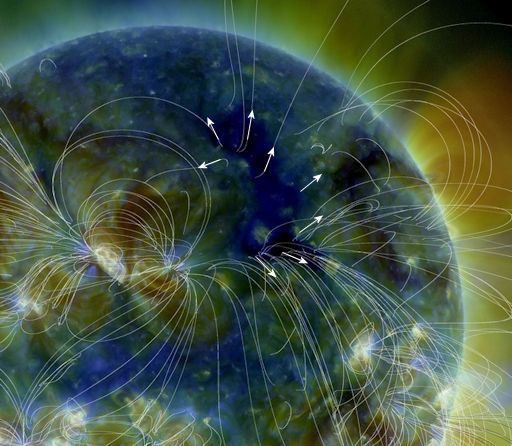SLIGHT CHANCE OF STORMS: NOAA forecasters estimate a 10% chance of polar geomagnetic storms on Sept. 23rd. That's when a minor CME could deliver a glancing blow to Earth's magnetic field. Because the weeks around equinoxes favor auroras, even a weak impact could spark a nice display. Arctic sky watchers should be alert for Northern Lights. Aurora alerts: text, voice.
CORONAL HOLE: NASA's Solar Dynamics Observatory is monitoring a coronal hole in the sun's northern hemisphere. It is the UV-dark region in this image taken during the early hours of Sept. 21st:
The white lines in the image trace the sun's magnetic field. A coronal hole is a place where the magnetic field spreads apart, allowing solar wind to escape. A stream of solar wind flowing from this particular coronal hole is heading for Earth, due to arrive on Sept. 23-24. Its arrival could add to the impact of a minor CME expected to reach Earth at about the same time. Polar geomagnetic storms are possible early next week. Aurora alerts: text, voice.
NORTHERN AUTUMNAL EQUINOX: The September equinox occurs at 4:44 p.m. EDT (20:44 UT) on Sunday, Sept. 22nd, when the Sun crosses the equator heading south. This marks the beginning of autumn in the northern hemisphere and spring in the southern hemisphere. You know the equinox is near when you find yourself nearly-blinded while driving down east-west roads. Alan Friedman demonstrates the phenomenon from his hometown in Buffalo, New York:
"At the equinoxes, the sun rises due east and sets due west on my street in Buffalo," says Friedman. "One has to drive carefully!"
Other signs of the season may be found in the Space Weather Photo Gallery. Happy Equinox!

Solar wind
speed: 415.6 km/sec
density: 2.7 protons/cm3
explanation | more data
Updated: Today at 1956 UT
X-ray Solar Flares
6-hr max: B4 1306 UT Sep21
24-hr: C1 0934 UT Sep21
explanation | more data
Updated: Today at: 1900 UT
![]()
Daily Sun: 21 Sep 13
Sunspot AR1850 is crackling with low-level C-class solar flares. Credit: SDO/HMI
![]()
Sunspot number: 85
What is the sunspot number?
Updated 21 Sep 2013
Spotless Days
Current Stretch: 0 days
2013 total: 0 days (0%)
2012 total: 0 days (0%)
2011 total: 2 days (<1%)
2010 total: 51 days (14%)
2009 total: 260 days (71%)
Since 2004: 821 days
Typical Solar Min: 486 days
Update 21 Sep 2013
The Radio Sun
10.7 cm flux: 109 sfu
explanation | more data
Updated 21 Sep 2013
![]()
Current Auroral Oval:
Switch to: Europe, USA, New Zealand, Antarctica
Credit: NOAA/POES
![]()
Planetary K-index
Now: Kp= 2 quiet
24-hr max: Kp= 3 quiet
explanation | more data
Interplanetary Mag. Field
Btotal: 3.2 nT
Bz: 2.9 nT south
explanation | more data
Updated: Today at 1956 UT
![]()
Coronal Holes: 20 Sep 13
Solar wind flowing from this coronal hole could reach Earth on Sept. 23-24. Credit: SDO/AIA.






